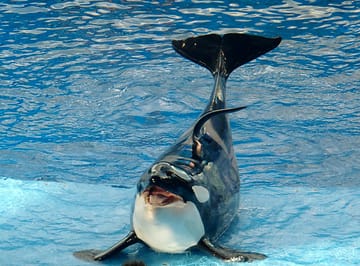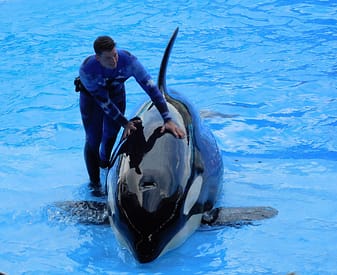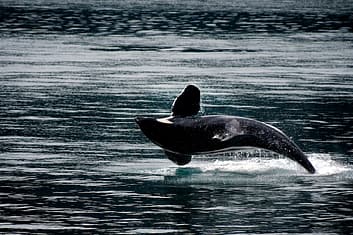[dropcap]T[/dropcap]he 1993 movie called “Free Willy” describes the bond of a young boy and an orca. Both coming from harsh pasts, the two befriend each other throughout the story. However, Dial, the owner of the park thinks that the whale’s value is in the profit it makes. I believe that mindset can be related to the corrupt place we have come to known called SeaWorld.
February 24, 2010 was just another regular day for whale trainer, Dawn Brancheau. Today was another highly anticipated Shamu show displaying the training and talents of the biggest killer whale in captivity in SeaWorld’s history, Tilikum. What Brancheau and SeaWorld did not know was that this day would infamously impact the “brand name” that Tilikum had begun for SeaWorld and that this event would trigger the movement to end killer whale captivity.
The Birth Of A Murderer

cojessmom / Pixabay
In 1983, a huge killer whale that would be known as Tilikum was caught in Iceland. After being captured in Iceland, Tilikum then spent most of the rest of his life in SeaWorld Orlando. While one would believe that living in a “sanctuary” that provided all of your needs and wants would be an enjoyable time, Tilikum had become living proof of the inconsistency of that statement due to the harsh bullying he received while he was living there. Tim Zimmerman, a co-writer of the very popular documentary on whale captivity in Seaworld titled Blackfish describes, “Instead of the iconic, happy killer whale celebrated by SeaWorld and its fans for five decades, Tilikum demanded the world confront his reality, Shamu’s reality, which involved separation from family, confinement, boredom, chronic disease, aggression among marine park killer whales, and aggression against trainers.”
[perfectpullquote align=”left” cite=”” link=”” color=”” class=”” size=””]Tilikum’s horrible reality caused 3 people to lose their lives over the course of 2 decades.[/perfectpullquote]
Tilikum’s attacking history began in an old 110 ft by 50 ft pool called Sealand. During his life there he resided with two other female killer whales who would often use his size and gender against him and rake their teeth along his fins. While this social structure is common among whales in captivity, the training ideas the Sealand trainers used on him were certainly not seen before. To help “improve” the behavioral issues that Tilikum was having, food would be withheld from him during training sessions. Tilikum’s sleeping quarters also involved a small packed metal pool that would keep all 3 whales in close quarters for up to 14 hours a night. From all aspects, Tilikum had no safe space for him to be a free roaming whale. During these times, Tilikum’s bullying became more intense and he started to become more aggressive, the type of aggressiveness that causes people to lose their lives.
Lives Lost But Never Forgotten

Aktim / Pixabay
Another trainer, Keltie Byrne, lost her life in February 21, 1991. This attack might not of had been a solo act by Tilikum, but spectators agree that Tilikum was the initiator of the attack. By far one of the most documented and notorious attacks done by Tilikum was the death of Dawn Brancheau. As another show of “Dine with Shamu” was coming to a close, Brancheau was suddenly pulled by her ponytail to the depths of the pool. Tilikum then pulled her around in the water, and after multiple takedowns into the water and thrashing around, it was over. Tilikum then took her to the bottom of the pool and sat there with his prize, Dawn Brancheau’s body. The occurrence was a lose-lose situation. Tilikum’s loss had happened as soon as he was captured and brought to SeaWorld and SeaWorld had lost one of their most amazing trainers and the trust of their people. While the death of Brancheau and Byrne was disheartening, the most horrible thing that arose from her death was the fact that SeaWorld had been documenting as much as 100 reports of aggression 20 years before her death, with 12 leaving a trainer injured or dead. SeaWorld had also ignored the danger of Tilikum, who had previous incidences with other whales and trainers. However, SeaWorld had pushed aside the risks and put the blame on Tilikum’s former home, Sealand, for not having proper safety standards for a massive whale and purchased Tilikum anyway.
“Lost” History And Life After Murder
A former Seaworld trainer named Samantha Berg claims, “My understanding of the animal’s past was very limited. In fact, there had been 30 incidents between killer whales, and trainers prior to me being hired at the park. And I didn’t know about any of them until after I left SeaWorld. So I think that’s a serious mistake on SeaWorld’s part that they weren’t letting people know the history of all the animals.”
The most depressing part about the deaths and life of Tilikum is the fact that people were not angry about Tilikum’s murders he had caused. John Hargrove, a senior trainer at SeaWorld states, “We did feel sorry for Tilikum, because we knew his life would be drastically changed forever. That he would become more isolated, with less contact and connection. We wanted him to be treated with dignity and respect on a daily basis, and not as a monster.” Tilikum then ended his career in the show business and spent most of his day in an isolated tank. He had no exposure to trainers and only the solemn looks from people passing by were the fans he received. This caused Tilikum to become depressed, and the isolation ate at him and made him become very sick.

skeeze / Pixabay
How The End Became The Beginning
Tilikum unfortunately died on January 6th, 2017 due to illness. However, the ending of his life doesn’t end his fight, the fight for which all wild animals in captivity: to be free. Certain safety precautions have been passed since the death of Brancheau and the life of Tilikum. Steel bars, separation and vests have been implemented to the regular shows now. Killer Whales at SeaWorld now have less contact with trainers as they had before. While one could argue the many deaths that have been caused at the hands, or fins, of Killer Whales are due to the aggravation of the animal towards the trainer, I choose to believe the whale is not angry at the trainer themselves, but what is beyond the trainer, a hazy future towards the abyss.
[perfectpullquote align=”left” bordertop=”false” cite=”” link=”” color=”” class=”” size=””]Not only did he display the negative impacts of captivity by killing people, but displayed the indecency that is captivity.[/perfectpullquote]
These amazing animals are not only taken from their families, but their lifestyle is dramatically altered. They are then moved into a small enclosed space, and forced to entertain people daily, but at the expense of their humanity and mentality. Tilikum is a significant piece in the puzzle of ending whale captivity.
The future generations should not be seeing such beautiful creatures kept in small pools, but seen in the wild with their families alongside. The thought of putting these animals into displays that earn profit should not even be recognized or thought of, as the beauty of the animal free in the wild fills the only void we would need to fill of experiencing the animal.
Featured Image by scooby12353




What do you think?
Show comments / Leave a comment